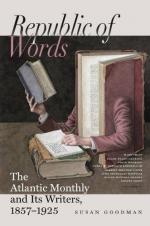I am willing,—I said,—to exercise your ingenuity in a rational and contemplative manner.—No, I do not proscribe certain forms of philosophical speculation which involve an approach to the absurd or the ludicrous, such as you may find, for example, in the folio of the Reverend Father Thomas Sanchez, in his famous tractate, “De Sancto Matrimonio.” I will therefore turn this levity of yours to profit by reading you a rhymed problem, wrought out by my friend the Professor.
THE DEACON’S MASTERPIECE: OR THE WONDERFUL “ONE-HOSS-SHAY.”
A LOGICAL STORY.
Have you heard of the wonderful one-hoss-shay,
That was built in such a logical way
It ran a hundred years to a day,
And then, of a sudden, it——ah,
but stay,
I’ll tell you what happened without
delay,
Scaring the parson into fits,
Frightening people out of their wits,—
Have you ever heard of that, I say?
Seventeen hundred and fifty-five. Georgius Secundus was then alive,— Snuffy old drone from the German hive! That was the year when Lisbon-town Saw the earth open and gulp her down, And Braddock’s army was done so brown, Left without a scalp to its crown. It was on the terrible Earthquake-day That the Deacon finished the one-hoss-shay.
Now in building of chaises, I tell you
what,
There is always somewhere, a weakest
spot,—
In hub, tire, felloe, in spring or thill,
In panel, or crossbar, or floor, or sill,
In screw, bolt, thoroughbrace,—lurking
still
Find it somewhere you must and will,—
Above or below, or within or without,—
And that’s the reason, beyond a
doubt,
A chaise breaks down, but doesn’t
wear out,
But the Deacon swore (as Deacons do,
With an “I dew vum,” or an
“I tell yeou,”)
He would build one shay to beat the taown
‘n’ the keounty ‘n’
all the kentry raoun’;
It should be so built that it couldn’
break daown:
—“Fur,” said the
Deacon, “’t’s mighty plain
Thut the weakes’ place mus’
stan’ the strain;
‘n’ the way t’ fix it,
uz I maintain,
Is only jest
To make that place uz strong uz the rest.”
So the Deacon inquired of the village
folk
Where he could find the strongest oak,
That couldn’t be split nor bent
nor broke,—
That was for spokes and floor and sills;
He sent for lancewood to make the thills;
The crossbars were ash, from the straightest
trees;
The panels of white-wood, that cuts like
cheese,
But lasts like iron for things like these;
The hubs of logs from the “Settler’s
ellum,”—
Last of its timber,—they couldn’t
sell ’em,—
Never an axe had seen their chips,
And the wedges flew from between their
lips,
Their blunt ends frizzled like celery-tips;
Step and prop-iron, bolt and screw,
Spring, tire, axle, and linchpin too,
Steel of the finest, bright and blue;
Thoroughbrace bison-skin, thick and wide;
Boot, top, dasher, from tough old hide
Found in the pit when the tanner died.
That was the way he “put her through.”—
“There!” said the Deacon,
“naow she’ll dew!”




